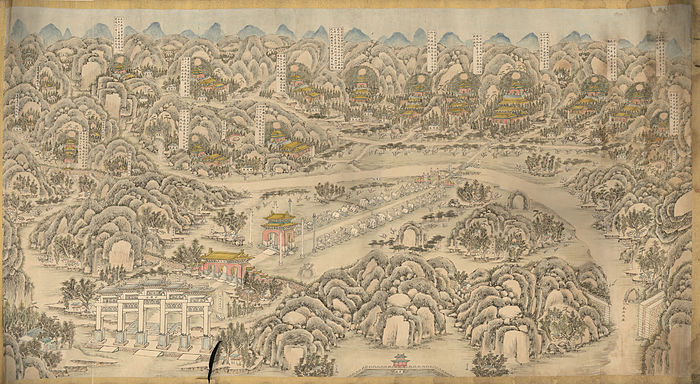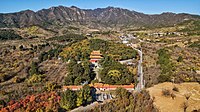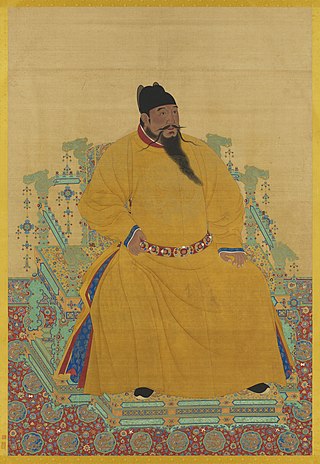
The Yongle Emperor, personal name Zhu Di, was the third emperor of the Ming dynasty, reigning from 1402 to 1424.
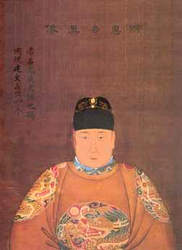
The Jianwen Emperor, personal name Zhu Yunwen (朱允炆), also known by his temple name as the Emperor Huizong of Ming (明惠宗) and by his posthumous name as the Emperor Hui of Ming (明惠帝), was the second emperor of the Ming dynasty, reigned from 1398 to 1402. Zhu Yunwen's father was Zhu Biao, the eldest son and crown prince of the Hongwu Emperor, the founder of the Ming dynasty. Zhu Biao died at the age of 37 in 1392, after which the Hongwu Emperor named Zhu Yunwen as his successor. He ascended the throne after the Hongwu Emperor's death in June 1398.

The Ming Xiaoling is the mausoleum of the Hongwu Emperor, the founder of the Ming dynasty. It lies at the southern foot of Purple Mountain, located east of the historical centre of Nanjing. Legend says that in order to prevent robbery of the tomb, 13 identical processions of funeral troops started from 13 city gates to obscure the real burying site.
Imperial Tombs of the Ming and Qing Dynasties is the designation under which the UNESCO has included several tombs and burial complexes in the list of World Heritage Sites. These tombs date from the Ming and Qing dynasties of China.

The Gate of China was a historical ceremonial gateway in Beijing, China, located near the center of latter-day Tiananmen Square. It was demolished in 1954. This gate formed the southern gate of the Imperial City during the Ming and Qing dynasties. It was situated on the central axis of Beijing, to the north of Zhengyang Gate, and south of Tiananmen. Unlike these two defensive gates, the Gate of China was a purely ceremonial gateway, with no ramparts, but was a brick-stone structure with three gateways.

The Ming Palace, also known as the "Forbidden City of Nanjing", was the 14th-century imperial palace of the early Ming dynasty, when Nanjing was the capital of China.

Zhaoling, also known as Beiling is the tomb of the first Qing emperor, Hong Taiji, and his Empress Xiaoduanwen.
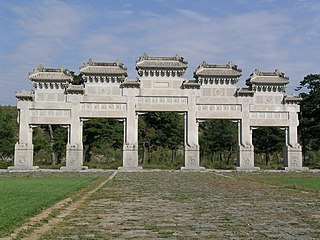
The Western Qing tombs are located some 140 km (87 mi) southwest of Beijing in Yi County, Hebei Province. They constitute a necropolis that incorporates four royal mausoleums where seventy-eight royal members are buried. These include four emperors of the Qing dynasty and their empresses, imperial concubines, princes and princesses, as well as other royal servants.

The Zhongshan Park was a former imperial altar and now a public park that lies just southwest of the Forbidden City in the Imperial City, Beijing.

The Eastern Qing tombs are an imperial mausoleum complex of the Qing dynasty located in Zunhua, 125 kilometres (78 mi) northeast of Beijing. They are the largest, most complete, and best preserved extant mausoleum complex in China. Altogether, five emperors, 15 empresses, 136 imperial concubines, three princes, and two princesses of the Qing dynasty are buried here. Surrounded by Changrui Mountain, Jinxing Mountain, Huanghua Mountain, and Yingfei Daoyang Mountain, the tomb complex stretches over a total area of 80 square kilometres (31 sq mi).

The Fuling or Fu Mausoleum, also known as the East Mausoleum, is the mausoleum of Nurhaci, the founding monarch of the Later Jin dynasty and his wife, Empress Xiaocigao. It served as the main site for ritual ceremonies conducted by the imperial family during the entire Qing dynasty. Located in the eastern part of Shenyang city, Liaoning Province, northeastern China, Fuling has been a UNESCO World Heritage Site since 2004.

Bixi, or Bi Xi, is a figure from Chinese mythology. One of the nine sons of the Dragon King, he is depicted as a dragon with the shell of a turtle. Stone sculptures of Bixi have been used in Chinese culture for centuries as a decorative plinth for commemorative steles and tablets, particularly in the funerary complexes of its later emperors and to commemorate important events, such as an imperial visit or the anniversary of a World War II victory. They are also used at the bases of bridges and archways. Sculptures of Bixi are traditionally rubbed for good luck, which can cause conservation issues. They can be found throughout East Asia and the Russian Far East.

A sacred way, spirit way, spirit road, spirit path, etc. is the ornate road leading to a Chinese tomb of a major dignitary. The sacred way is lined on both sides by a succession of statues, pillars, and stelae. The statues along the spirit way depict real and mythical animals, as well as civilian and military officials.

The Yangshan Quarry is an ancient stone quarry near Nanjing, China. Used during many centuries as a source of stone for buildings and monuments of Nanjing, it is preserved as a historic site. The quarry is famous for the gigantic unfinished stele that was abandoned there during the reign of the Yongle Emperor in the early 15th century. In scope and ambition, the stele project is compared to other public works projects of Yongle era, which included the launching of the treasure fleet for Zheng He's maritime expeditions and the construction of the Forbidden City in Beijing.

The Ming Ancestors Mausoleum, Ming Ancestor Tomb, or Zuling Tomb was the first imperial mausoleum complex of the Ming dynasty, constructed at a geomantically advantageous site near the inlet of the Huai River into the west side of Hongze Lake in present-day Xuyi County, Huai'an Prefecture, Jiangsu Province, China. Built between 1386 and 1413 by Zhu Yuanzhang—the Hongwu Emperor who founded the Ming—and his son Zhu Di the Yongle Emperor to display their filial piety, it was located north of the town of Sizhou, where the ancestors of the dynasty had lived. The remains of the Hongwu Emperor's grandfather Zhu Chuyi are known to have been disintered and moved to the site. He, his father Zhu Sijiu, and his grandfather Zhu Bailiu were posthumously revered at the site as honorary emperors, Zhu Chuyi as the Xi Ancestor of the Ming (Xizu), Zhu Sijiu as the Yi Ancestor of the Ming (Yizu), and Zhu Bailiu as the De Ancestor of the Ming (Dezu).

The Tomb of the King of Boni is the tomb of Abdul Majid Hassan, the ruler of Boni, a medieval state on the island of Borneo sometimes considered to be the predecessor of modern Brunei. It and its associated statuary are located in a park at the southern foothills of Tortoise Mountain (Guishan), about 3km south of the southern gate of the walled city of Nanjing.
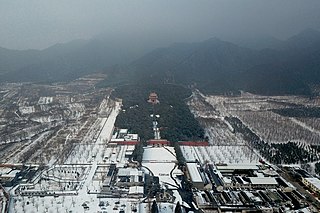
The Ming Dingling is a mausoleum in China where the Wanli Emperor, together with his two empresses Wang Xijie and Dowager Xiaojing, was buried. Dingling is one of the thirteen imperial tombs at Ming tombs in Changping district 45 km north of central Beijing. The Dingling is the only tomb of a Ming dynasty emperor that has been excavated since the founding of the People's Republic of China, a situation that is almost a direct result of the fate that befell Dingling and its contents after the excavation.

The Western Han dynasty imperial tombs are a series of eleven imperial burial grounds from the Chinese Western Han Dynasty in Shaanxi Province. Two of the emperor's mausoleums are located southeast of today's Xi'an, which was then the capital of the Western Han Dynasty, Chang'an, and the other nine mausoleums are located in a string of pearls in an east-west direction north of the Wei River in Xianyang Prefecture north of Xi'an. The line of tombs stretches from Xingping in the west to Pingling in the east. The nine burial areas can be roughly divided into three districts: the eastern one around Changling with Anling and Yangling, the western one with Maoling and Pingling and the central district around Weiling with Yanling, Yiling and Kangling. There were officially thirteen emperors who ruled the Western Han Dynasty. Empress Dowager Lü does not have her own tomb but is buried together in Changling with Liu Bang. It is unclear where the last emperor of the Western Han Dynasty, Ruzi Ying, is buried. The construction of the tomb complexes usually started during the respective emperor's second year as regent.

The Jingtai Mausoleum is the mausoleum of the Jingtai Emperor, the seventh emperor of the Ming dynasty. It is located in the Haidian District, 17 km northwest of central Beijing, and is situated north of Jingming Park.

The Ming Zhaoling is a mausoleum in China where the Longqing Emperor was buried. Zhaoling is one of the thirteen imperial tombs at Ming tombs in Changping district 45 km north of central Beijing.





